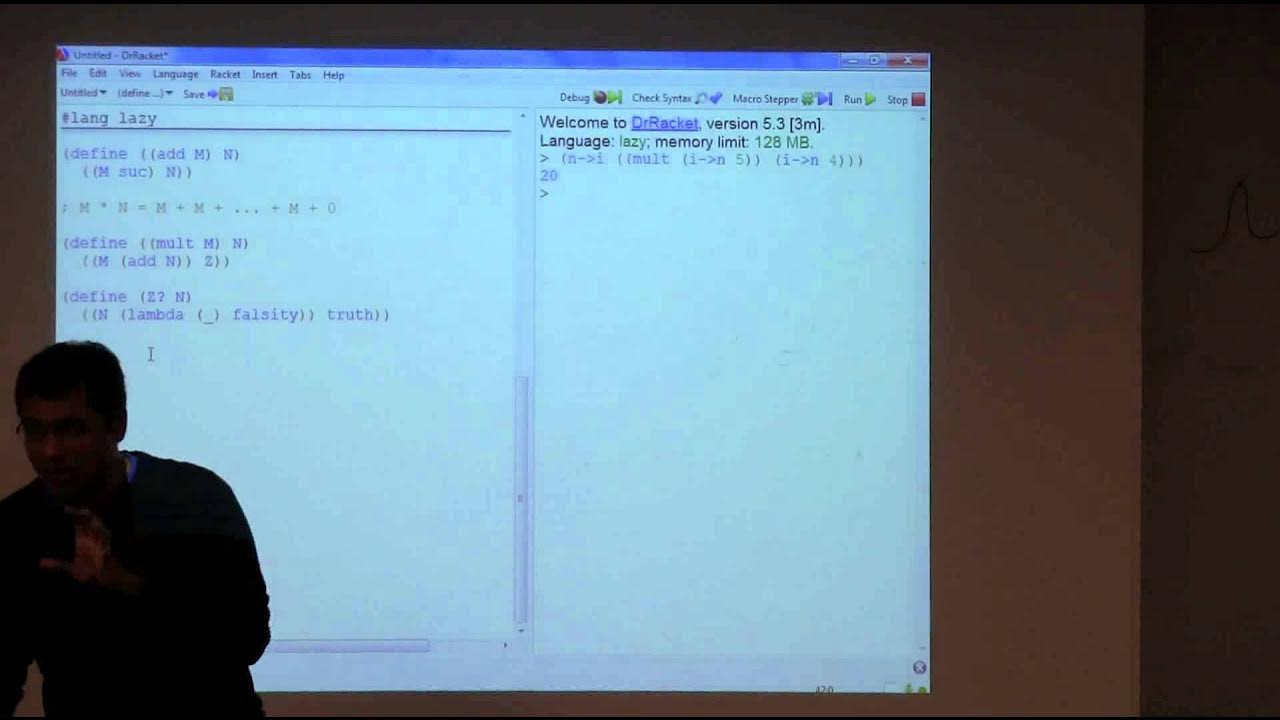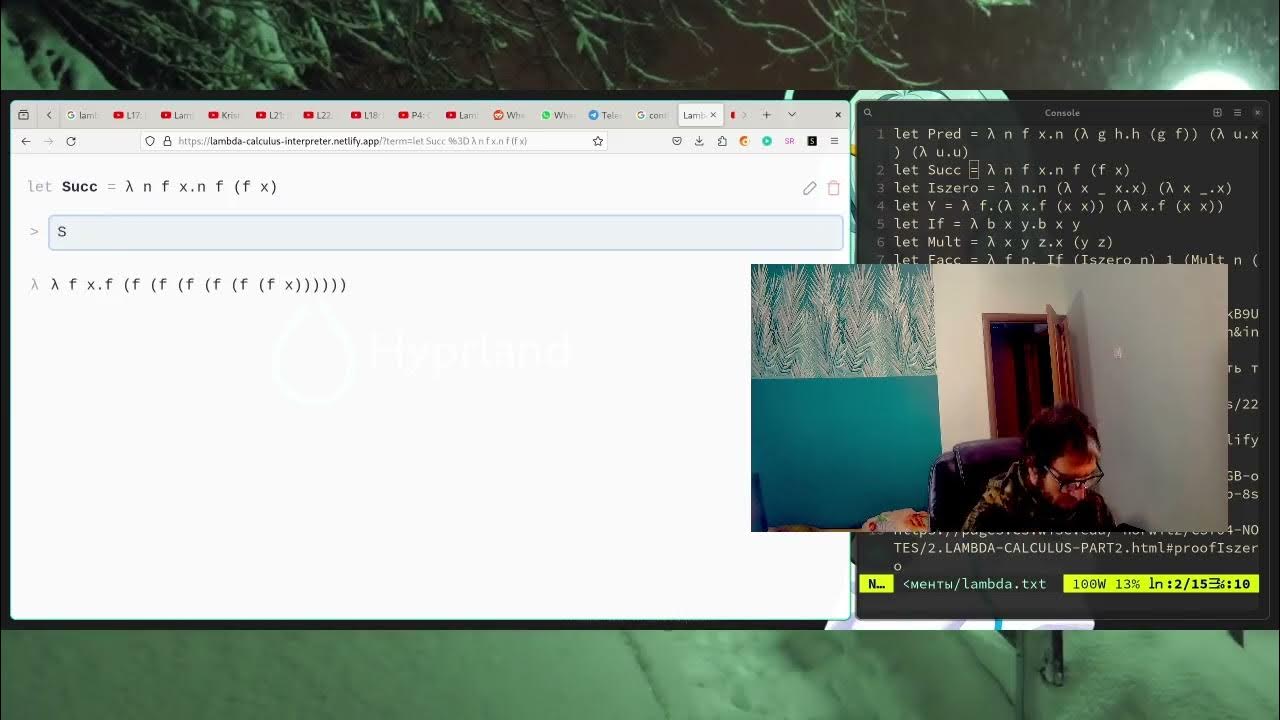Pairs with lambda calculus
TLDRThe transcript discusses the concept of pairs in Lambda calculus, a fundamental aspect of functional programming. It explains how pairs are represented using a Lambda expression that encapsulates two elements and an accessor function 'f'. The process includes defining the pair constructor and accessor functions for the first and second elements. The script illustrates constructing pairs and accessing their elements, highlighting the flexibility of higher-order functions in Lambda calculus.
Takeaways
- 🧑💻 Lambda calculus represents pairs using a lambda expression that encapsulates two elements and an accessor function.
- 🔑 The pair is constructed by applying the accessor function 'F' to two elements 'A' and 'B', allowing the creation and access to the pair.
- 📦 The definition of a pair in Lambda calculus involves a high-order function that takes a function 'F' and two elements 'A' and 'B'.
- 🔍 Accessor functions are used to retrieve the first and second elements of the pair, providing a way to access the individual components.
- 👉 The 'first' function is defined to take a pair and return its first element, allowing for the extraction of 'A' from the pair.
- 👈 Similarly, the 'second' function is defined to return the second element of the pair, providing access to 'B'.
- 🔄 Constructing a pair involves using a lambda expression with a high-order function that can internally access elements 'X' and 'Y'.
- 📝 When the constructed pair is accessed using the first or second function, it returns the respective element of the pair.
- 🎯 The type of the lambda expression is defined by the type of the term it reduces to, either the first or second element.
- 📚 The script provides an example of how to construct and access pairs in Lambda calculus, demonstrating the practical application of the concept.
- 🌐 The explanation of pairs in Lambda calculus is part of a broader educational discourse on functional programming and theoretical computer science.
Q & A
What is the Lambda calculus?
-The Lambda calculus is a formal system in mathematical logic and computer science for expressing computation through function abstraction and application using variable binding and substitution.
How are pairs represented in the Lambda calculus?
-Pairs in the Lambda calculus are represented as a lambda expression that takes two arguments and provides access to these two elements through an accessor function.
What is an accessor function in the context of Lambda calculus pairs?
-An accessor function is a function that, when applied to a pair, returns either the first or the second element of the pair.
Can you provide an example of how to construct a pair in Lambda calculus?
-A pair can be constructed using a lambda expression, such as 'λf.λx.λy.f x y', which takes a function 'f' and two elements 'x' and 'y', and applies 'f' to 'x' and 'y'.
What is the purpose of the first and second accessor functions in Lambda calculus?
-The first and second accessor functions are used to retrieve the first and second elements, respectively, from a pair constructed in Lambda calculus.
How does the first accessor function work in Lambda calculus?
-The first accessor function takes a pair and returns its first element, effectively providing access to the first component of the pair.
How does the second accessor function work in Lambda calculus?
-The second accessor function takes a pair and returns its second element, allowing access to the second component of the pair.
Can you explain the concept of a higher-order function in Lambda calculus?
-A higher-order function in Lambda calculus is a function that takes one or more functions as arguments or returns a function as its result. It allows for the abstraction and manipulation of other functions.
What is the significance of the Lambda expression in representing pairs?
-The Lambda expression for representing pairs encapsulates both the elements of the pair and the mechanism for accessing them, making it a compact and expressive way to handle pairs in Lambda calculus.
How does the type of a Lambda expression for a pair relate to the elements it contains?
-The type of a Lambda expression for a pair is determined by the types of the elements it contains. When the expression is reduced, it will yield an element of the type corresponding to the first or second element, depending on the accessor function applied.
Outlines
🤖 Lambda Calculus Pair Representation
The paragraph discusses the concept of representing pairs in the Lambda calculus. It explains that a pair in Lambda calculus is represented as a function that takes two elements and an accessor function. The body of the Lambda expression is the application of the accessor function to the two elements, allowing for the construction and access to the pair. The paragraph also describes how to define accessor functions for retrieving the first and second elements of the pair. It provides an example of constructing a pair with variables X and Y and accessing the elements using the defined accessor functions. The paragraph concludes with an explanation of how the Lambda expression is used to access the elements based on the type of the term.
Mindmap
Keywords
💡Lambda calculus
💡Pair
💡Accessor function
💡First element
💡Second element
💡Function abstraction
💡Application
💡High-order function
💡Type
💡Reduction
Highlights
Pairs in the Lambda calculus are represented as a Lambda which takes the first and second elements of the pair.
The Lambda also includes an accessor function to access the elements of the pair.
The body of the Lambda expression applies the accessor function to the elements A and B.
The ability to construct a pair and access its elements is provided by this Lambda expression.
An accessor function is defined to extract the first element of the pair.
Another accessor function is defined to extract the second element of the pair.
The pair can be constructed using any elements X and Y.
Accessing the first element of the pair retrieves the first element.
Accessing the second element of the pair retrieves the second element.
The pair can be represented as a Lambda expression with a higher-order function.
The higher-order function takes a function that can access the internal elements X and Y.
The type of the Lambda expression is defined based on the types of the terms X and Y.
The Lambda expression can be reduced to the first or second element depending on the accessor function used.
The representation of pairs in Lambda calculus allows for flexible access to elements within the pair.
The method demonstrates a practical application of Lambda calculus in constructing and accessing pairs.
The use of higher-order functions in Lambda calculus enhances the expressiveness of the language.
The Lambda calculus approach to pairs provides a theoretical foundation for functional programming.
Transcripts
Browse More Related Video

A Flock of Functions: Lambda Calculus and Combinatory Logic in JavaScript | Gabriel Lebec @ DevTalks

Lambda (λ) Calculus Primer

Programming Languages - The Lambda Lecture

Lambda Calculus Calculator

Lambda Calculus: The foundation of functional programming, and the simplest programming language

PLT: Lambda Calculus - Basics 1
5.0 / 5 (0 votes)
Thanks for rating: